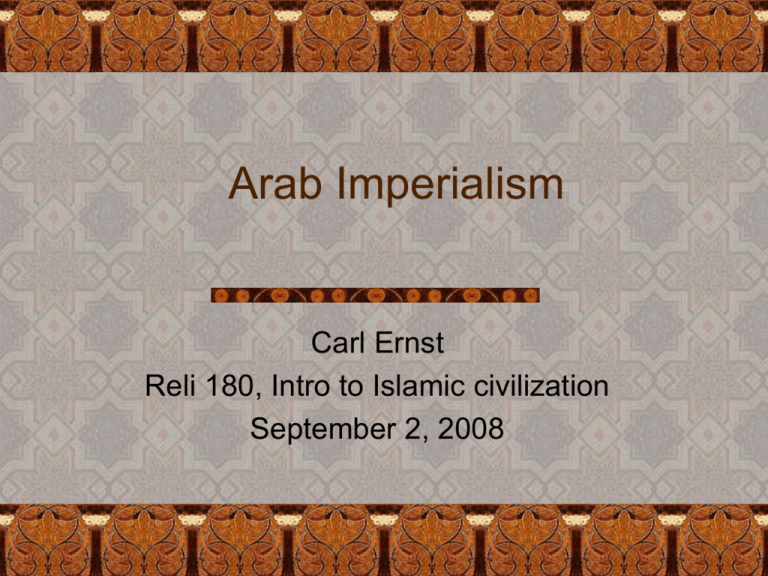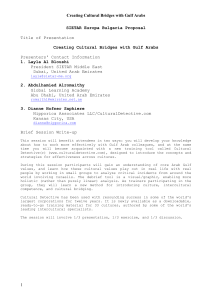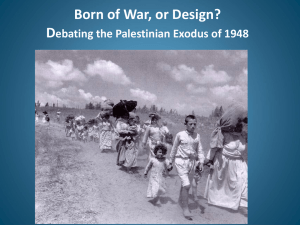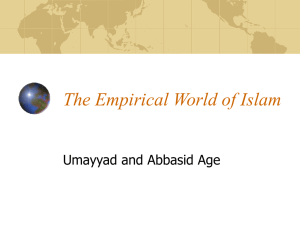Notes
advertisement

Arab Imperialism Carl Ernst Reli 180, Intro to Islamic civilization September 2, 2008 A note on revisionist historians Egger, page 32: Patricia Crone, John Wansborough, etc. Questions speculating about traditional Muslim sources, the geographical location of Islam, and the codification of the Qur’an. Debate cannot be dismissed, but documentary evidence is lacking for these theories 2 Arab Imperialism -- overview Conquest of Persian and much of Byzantine Empire Two empires exhausted Battle over relic of “True Cross” Conquered territories as a cash cow for exploitation rather than expansion of Islamic society Amazingly swift conquests Administration of Muslims and non-Muslims 3 4 Arab conquests: Arabia and Fertile Crescent Factions emerge to contest leadership Muslim emigrants to Medina (Muhajirun) Muslims in Medina (Ansar) Last-minute Muslim converts in Mecca Wars of Apostasy (ridda) afte Muhammad’s death, two major transitions Subduing rebellious tribes, then all Arab communities Conquering Arabian Peninsula, then invading Byzantine and Persian empires 5 Factors aiding the conquest Expansion of Arabs’ geopolitical motives beyond securing borders Inspiration of religion combined with the promise of loot Nomadic reliance on raiding settlements, channeled outwards as Arabia is unified problem of handling new military recruits, need for further conquests 6 Byzantine weakness in Syria Large Arab population Defensive tactics Byzantine troops were two thirds Arab Monophysite Christians and Jews disliked Byzantine oppression Damascus captured 636, becomes military and political center of caliphate 7 Conquest of Iraq and Egypt Arab armies defeat Sasanian forces in North and South Iraq by 638 `Amr ibn al-`As conquers Egypt, 636-641, welcomed by Coptic Christians Garrison cities (Kufah, Basrah; Fustat [Cairo]) established for Arab armies, keeping them separate from the locals 8 Iran Conquest proceeds despite death of 2nd Caliph, `Umar (644) Fars (Persian heartland) subjugated by 650, Khorasan (NE) by 654 Distractions of civil war after assassination of `3rd Caliph, `Uthman (656), as 4th Caliph, `Ali, fights Mu`awiya ( Damascus) up to his murder in 661 9 Other regions (rapid conquests learned about much after the fact) North Africa: integration of Berber nomads into conquering army Spain (711, at the request of Visigoths), Muslims welcomed by Jewish population 50,000 Arabs sent to colonize Central Asia (Merv, 671) Non-Muslim Syrians and Iranians join army Indus valley conquered in 711 10 Umayyad administration: the caliphate Election of Abu Bakr as 1st Caliph ( 632634), tribal form of succession and allegiance oath Earliest title: khalifat Allah, “deputy of God” (up to Abbasids)—theological Later changed to khalifat rasul Allah, “successor of the messenger of God” Finally “Commander of the Faithful”, military and prayer leader 11 Umayyad administration: administration of non-Muslims Correction to Egger (47): while chronicles suggest violent campaigns, ceramic archaeological evidence indicates slower peaceful penetration of Arabs (Prof. Jodi Magness) Arabs adopt Sasanian policy of recognizing other religious groups and leaders, rather than Byzantine orthodoxy model Tax (jizya) on non-Muslims 12 Umayyad administration: administration of Muslims Controlling armies by settlement in garrison towns Shift from loot to regular pay for soldiers, land revenue Non-Arab converts adopted as clients of Arab tribes Inequality and tension with non-Arab Muslims Tax incentive to conversion 13 Umayyad administration: administration of Muslims (2) Gender and regulation of women’s roles Social rules of women in Arabia Debated verses from Qur’an on polygamy, inheritance, dowry, divorce, modesty Debated origins of veiling and seclusion – Sasanian and Byzantine upper-class women Continuation of previous empires’ tax collectors, languages, coins Imposition of Arabic as state language, construction of Dome of the Rock ( 691) 14 Dome of the Rock, Jerusalem (691): imperial and religious 15 Dome of the Rock Interior view 16 Dome of the Rock Qur’an inscriptions the earliest dated version of the text; mostly about Qur’anic doctrine of Jesus as human prophet 17 Dome of the Rock Royal motifs of crown and jewels, suggesting imperial tribute 18 An Umayyad Palace: Khirbat alMafjar (742-3, near Jericho) 19 Painting behind the throne: the world-emperor 20 To side of throne Salutations from the kings of the world, in Greek and Arabic 21 Paintings in the bath 22 Greek zodiac on ceiling dome 23 Dissolution of Arab Empire Limits of conquest machine Garrison cities fail to segregate Arabs from locals – ethnic and cultural mixing (Arabs learn Persian, non-Muslims Arabized) Problem of maintaining Arab armies, limits of plunder as source of revenue Rebellions among Iranians, also Berbers (740) Instability, overthrow Umayyads in 750 24 Conclusion Umayyad Empire based on constant conquests, “the exploitation of non-Arabs for the benefit of Arabs” Islamic and Arabic identity now spread beyond the Arabs through religion and language, tied to empire Important cultural and administrative continuity with previous empires 25






